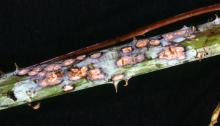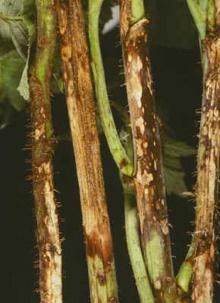Cause Elsinoe necator, a fungus widespread in the Pacific Northwest in black and occasionally in red raspberry cultivars. All black raspberry cultivars are susceptible. The disease is not always severe enough to warrant the cost of spraying. It is particularly serious if rains continue late in spring, when spots on canes may be plentiful enough to girdle canes. Early-season infections are more severe than late-season ones.
Symptoms Circular sunken spots, about 0.12 inch or more in diameter, form on lower canes. At first, infections are purplish; later, the center turns gray. As canes age, spots become sunken, and margins are raised and purplish. Current-season canes show initial symptoms near the ground. Most infection is on the side of the cane toward the plant's center and from 6 to 30 inches up the cane. Infection often results in uneven berry ripening. On leaves, minute purple spots develop, which enlarge and coalesce to form gray to white areas. Such areas may drop out. Partial defoliation may result. Flowers and fruit may also be infected. Druplets may remain small and are pitted and are slow to ripen.
Cultural control
- Use certified planting stock.
- Cut away old fruiting canes close to the ground and burn them at once.
- Remove all infected and dead canes after harvest.
- Maintain less dense, narrow rows for better air circulation.
- Avoid overhead irrigation, or limit the time plants are wet from irrigation.
- Remove wild brambles near commercial plantings.
- Resistant red raspberry cultivars include Autumn Bliss, Chilcotin, Heritage, Meeker, Nootka, and Willamette.
Chemical control
- Late dormant or delayed dormant. Further control not needed in most years.
- Bordeaux 8-8-100. Group M1 fungicide. O
- Fixed coppers such as Nu-Cop, C-O-C-S, Nordox, Cuprofix, or Kocide most with a 48-hr reentry. Group M1 fungicides. Monterey Liqui-Cop or Bonide Copper Fungicide for the home. H O
- Rex lime sulfur (28%) at 6 to 12 gal/100 gal water. 48-hr reentry. O
- Sulforix at 3 gal/100 gal water. 48-hr reentry.
- When new canes are 6 to 12 inches high may be effective if disease pressure is great.
- Abound at 6 to 15.5 fl oz/A. Do not apply with silicone-based surfactants. May be applied on the day of harvest. 4-hr reentry.
- Bonide Captan 50 WP at 3 Tbsp/gal water can be used in home gardens. Washington only. Do not use within 3 days of harvest. H
- Cabrio EG at 14 oz/A. May be used at harvest. Group 11 fungicide. 12-hr reentry.
- Captan 80 WDG at 2.5 lb/A. Do not apply within 3 days of harvest. Group M4 fungicide. 48-hr reentry.
- CaptEvate 68 WDG at 3.5 lb/A Do not apply more than two (2) consecutive application, within 3 days of harvest or more than 17.5 lb/A/season. Group 17 + M4 fungicide. 48-hr reentry.
- Pristine at 18.5 to 23 oz/A. Do not use with any other tank additive. Can be used day of harvest. Group 7 + 11 fungicide. 12-hr reentry.
- QuiltXcel at 14 to 21 fl oz/A. Do not use within 30 days of harvest. Sprayers should not be used on apples. Group 3 + 11 fungicide. 12-hr reentry.
Note: Switch is registered for anthracnose caused by Colletotrichum spp. and it is not clear if it would be effective on anthracnose of raspberry.
Reference Munro, J.M., Dolan, A., and Williamson, B. 1988. Cane spot (Elsinoe veneta) in red raspberry: Infection periods and fungicidal control. Plant Pathology 37:390-396.


